

German Bestelmeyer (8 June 1874 – 30 June 1942) was a German architect, university lecturer, and proponent of Nazi architecture. Most of his work was in South Germany.


German Bestelmeyer (8 June 1874 – 30 June 1942) was a German architect, university lecturer, and proponent of Nazi architecture. Most of his work was in South Germany.
Bestelmeyer was born in Nuremberg, the son of a military doctor. He studied architecture from 1893 to 1897 at the Technical University of Munich under Friedrich von Thiersch and at the Academy of Fine Arts Vienna under Friedrich von Schmidt.
Bestelmeyer worked as a building inspector and planner in Nuremberg, Regensburg, and at the University of Munich, where he designed an extension to the main building that was built between 1906 and 1910.
In 1910 he was appointed to a professorship at Technische Universität Dresden. The following year he transferred to the Dresden Academy of Fine Arts, and in 1915 to the Berlin University of the Arts. In 1919 he also became a professor at Technische Universität Berlin. In 1922 he returned to Munich as a professor at the Technical University of Munich, and from 1934 until his death in 1942 he was President of the Academy of Fine Arts, Munich.
Bestelmeyer was an outspoken advocate of traditionalist völkisch architecture. He was a member of the Munich School to which Paul Troost also belonged. In 1928, with Paul Schultze-Naumburg, Paul Schmitthenner and others, he founded "The Block", a group of architects in opposition to the modernist group Der Ring. [1] [2]
Bestelmeyer was singled out for praise in 1931 by Schultze-Naumburg and in 1934, shortly after Adolf Hitler's rise to power, wrote an article in which he endorsed Alexander von Senger's criticism of Le Corbusier, described 1920s architecture as having become "soulless", and rejected flat roofs as unsuited to the climate in Germany. [1] He was a member of both the Deutscher Werkbund and the antisemitic Militant League for German Culture. [3] He became a Reich Cultural Senator in 1935. [4]
Bestelmeyer brought von Senger to the Bavarian Academy and designed buildings such as the Luftwaffe office building on the Prinzregentenstraße in Munich, which were much praised at the time. [5] However, he also designed a number of mostly Protestant churches, some of which met with official approval, [6] and Hitler chose his design for the Mangfall Bridge, a girder bridge on two massive concrete pylons carrying one of the new Reichsautobahns, which was influential in its simple modernity and size. [7] [8]
Bestelmeyer died in 1942 at the resort of Bad Wiessee. On Hitler's orders, his body was brought back to Munich and after lying in state in the Academy of Fine Arts, transferred for the state funeral to the light-court of the University of Munich which he had designed, with 300 members of the Hitler Youth in attendance.

Berthold Konrad Hermann Albert Speer was a German architect who served as the Minister of Armaments and War Production in Nazi Germany during most of World War II. A close ally of Adolf Hitler, he was convicted at the Nuremberg trials and sentenced to 20 years in prison.

Hermann Wilhelm Göring was a German politician, military leader, and convicted war criminal. He was one of the most powerful figures in the Nazi Party, which governed Germany from 1933 to 1945.
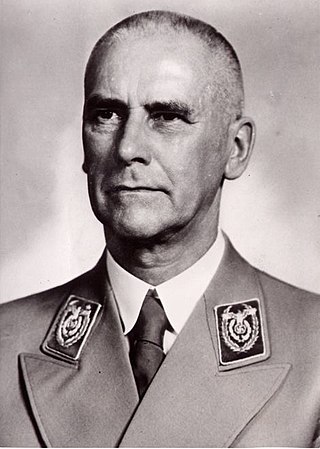
Wilhelm Frick was a convicted war criminal and prominent German politician of the Nazi Party (NSDAP) who served as Minister of the Interior in Adolf Hitler's cabinet from 1933 to 1943 and as the last governor of the Protectorate of Bohemia and Moravia.

Fritz Todt was a German construction engineer and senior figure of the Nazi Party. He was the founder of Organisation Todt (OT), a military-engineering organisation that supplied German industry with forced labour, and served as Reich Minister for Armaments and Ammunition in Nazi Germany early in World War II, directing the entire German wartime military economy from that position.

The Reich Chancellery was the traditional name of the office of the Chancellor of Germany in the period of the German Reich from 1878 to 1945. The Chancellery's seat, selected and prepared since 1875, was the former city palace of Adolf Friedrich Count von der Schulenburg (1685–1741) and later Prince Antoni Radziwiłł (1775–1833) on Wilhelmstraße in Berlin. Both the palace and a new Reich Chancellery building were seriously damaged during World War II and subsequently demolished.
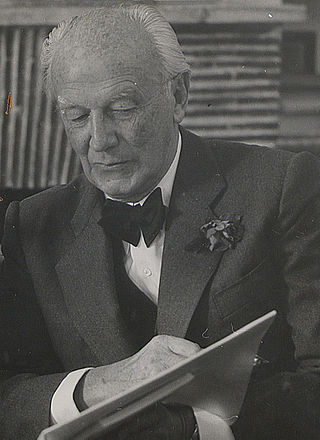
Paul Bonatz was a German architect, member of the Stuttgart School and professor at the technical university in that city during part of World War II, and from 1954 until his death. He worked in many styles, but most often in a simplified neo-Romanesque, and designed important public buildings both in the Weimar Republic and under the Third Reich, including major bridges for the new autobahns. In 1943 he designed several buildings in Turkey, returning to Stuttgart in 1954.
Ernst Sagebiel was a German architect.
Alexander von Senger, was a Swiss architect and architectural theorist.

Paul Schultze-Naumburg was a German traditionalist architect, painter, publicist and author. A leading critic of modern architecture, he joined the Nazi Party in 1930 and became an important advocate of Nazi architecture.
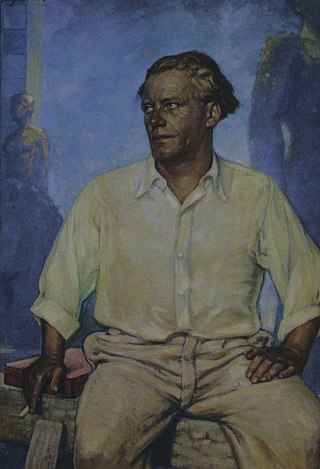
Josef Thorak was an Austrian-German sculptor. He became known for oversize monumental sculptures, particularly of male figures, and was one of the most prominent sculptors of the Third Reich.

Eugen Hönig was an architect in Nazi Germany. He was the inaugural president of the Reich Chamber of Culture.

Louis Rudolph Franz Schlegelberger was State Secretary in the German Reich Ministry of Justice (RMJ) who served as Justice Minister during the Third Reich. He was the highest-ranking defendant at the Judges' Trial in Nuremberg.
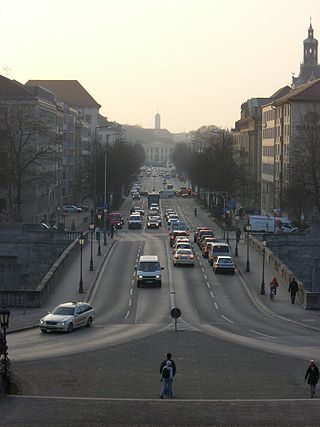
The Prinzregentenstraße in Munich is one of four royal avenues and runs parallel to Maximilianstraße and begins at Prinz-Carl-Palais, in the northeastern part of the Old Town. The avenue was constructed from 1891 onwards as a prime address for the middle-class during the reign of Luitpold, Prince Regent of Bavaria and is named in his honour. The square in the eastern part of the street is named Prinzregentenplatz.

The Ludwigstraße in Munich is one of the city's four royal avenues next to the Brienner Straße, the Maximilianstraße and the Prinzregentenstraße. The avenue is named after King Ludwig I of Bavaria. The city's grandest boulevard still maintains its architectural uniformity envisioned as a grand street "worthy the kingdom" as requested by the king. The Ludwigstraße has served for state parades and funeral processions.
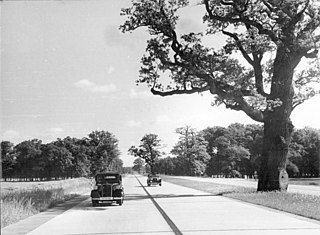
The Reichsautobahn system was the beginning of the German autobahns under Nazi Germany. There had been previous plans for controlled-access highways in Germany under the Weimar Republic, and two had been constructed, but work had yet to start on long-distance highways. After previously opposing plans for a highway network, the Nazis embraced them after coming to power and presented the project as Hitler's own idea. They were termed "Adolf Hitler's roads" and presented as a major contribution to the reduction of unemployment. Other reasons for the project included enabling Germans to explore and appreciate their country, and there was a strong aesthetic element to the execution of the project under the Third Reich; military applications, although to a lesser extent than has often been thought; a permanent monument to the Third Reich, often compared to the pyramids; and general promotion of motoring as a modernization that in itself had military applications.

The Mangfall Bridge is a motorway bridge across the valley of the Mangfall north of Weyarn in Upper Bavaria, Germany, which carries Bundesautobahn 8 between Munich and Rosenheim. The original bridge, designed by German Bestelmeyer, opened in January 1936 as one of the first large bridges in the Reichsautobahn system and was influential in its design. Destroyed at the end of World War II, this bridge was replaced with a temporary structure in 1948; the current bridge consists of a replacement built in 1958–60 to a design by Gerd Lohmer and Ulrich Finsterwalder and a second span for traffic in one direction which was added in the late 1970s when the autobahn was widened to six lanes.

The Munich Secession was an association of visual artists who broke away from the mainstream Munich Artists' Association in 1892, to promote and defend their art in the face of what they considered official paternalism and its conservative policies. They acted as a form of cooperative, using their influence to assure their economic survival and obtain commissions. In 1901, the association split again when some dissatisfied members formed the group Phalanx. Another split occurred in 1913, with the founding of the New Munich Secession.

Nazi architecture is the architecture promoted by Adolf Hitler and the Nazi regime from 1933 until its fall in 1945, connected with urban planning in Nazi Germany. It is characterized by three forms: a stripped neoclassicism, typified by the designs of Albert Speer; a vernacular style that drew inspiration from traditional rural architecture, especially alpine; and a utilitarian style followed for major infrastructure projects and industrial or military complexes. Nazi ideology took a pluralist attitude to architecture; however, Hitler himself believed that form follows function and wrote against "stupid imitations of the past".

Volker Staab is a German architect.